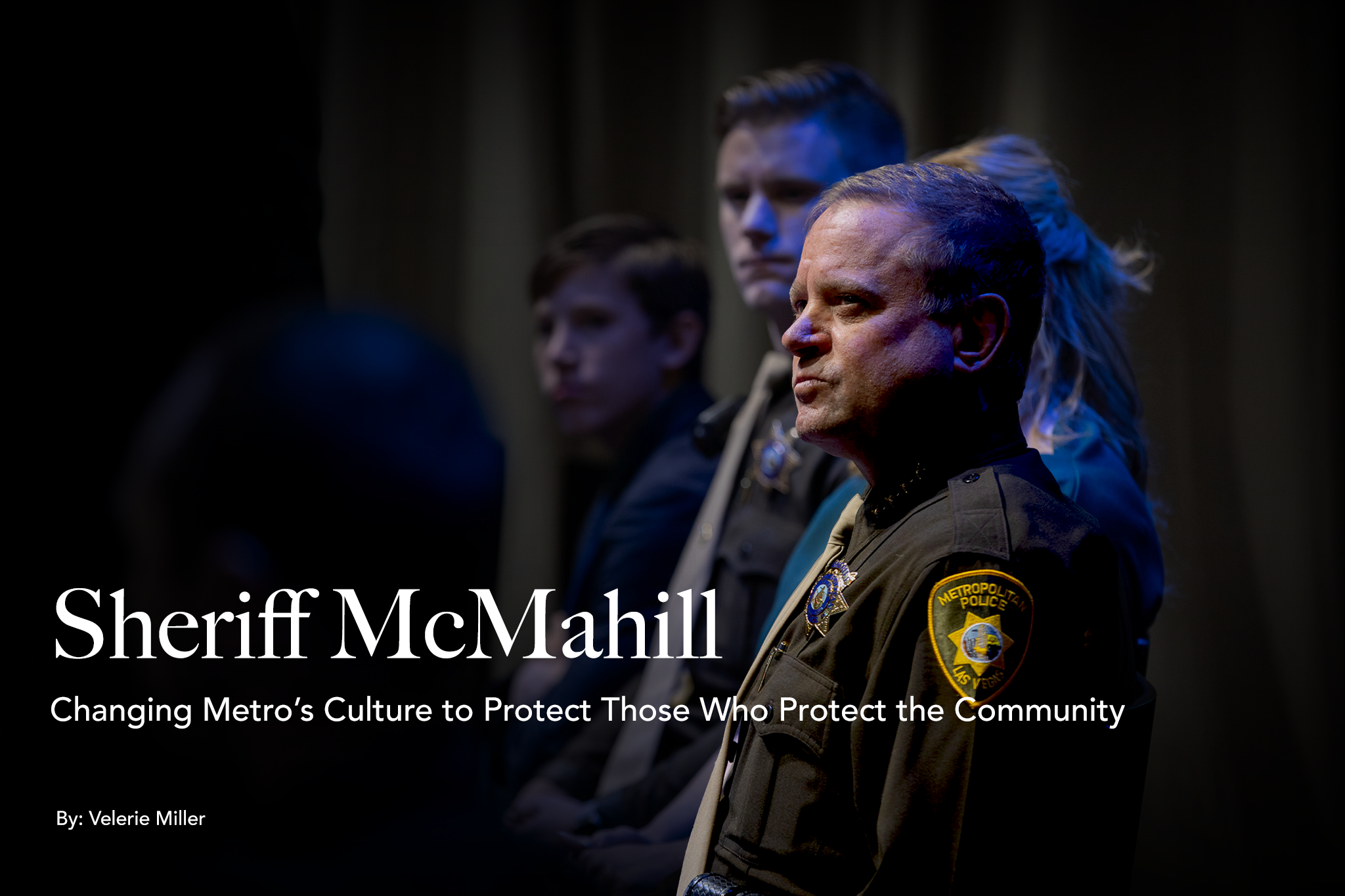
Clark County Sheriff Kevin McMahill is marking his first year on the job in a big way. His goals not only include protecting the residents of Southern Nevada, but taking special care of his officers as well.
One year into his job leading the Las Vegas Metropolitan Police Department, McMahill knows the toll protecting the public takes on his officers. He worked for Metro for 30 years before retiring. Today, he is working to protect both the physical and mental health of those in his department.
“I believe if I focus on taking care of our officers in ways we never have, they’re going take care of this community in ways we never have,” he says.
For years, police officers have suffered in silence. Cops were afraid of the career consequences of seeking professional help for the psychological scars left by seeing the very worst things humans do to one another. That strong-silent image was the cultural norm in the department. But not anymore, McMahill says.
“I am smashing that culture as fast as I possibly can,” the new sheriff promises. To that end, McMahill has set up support services to actively reach out to his officers.
“I’ve hired five licensed clinical social workers, including one doctor, to start to work on seeing my people, and taking care of them in ways that we never have,” he says. The programs will also be expanded beyond Metro, to include other first responders, like EMTs.
Mental health problems can also linger long after cops hang up their badges. Former officers may lose their sense of purpose after retiring, McMahill explains. And with police suicides a rising problem, nationally, McMahill points to a tragic example close to home: “We just lost one of our retirees to suicide (in February).”
Viewing, or even hearing about graphic details of gruesome murders, car accidents, rapes or child abuse takes its toll on a person’s psyche, McMahill notes.
“This stuff messes with our people,” he says. “And I just think it’s time for law enforcement leadership across this country to stand up and do something about this so we can change the narrative on suicides and depression, alcoholism, divorce — all the bad things we don’t want to lead in anymore.”
Excelling Under Pressure
Both as a cop and as sheriff, McMahill knows all about pressure of working in law enforcement. He has lived it for more than 30 years. McMahill’s wife is also a retired LVMPD Deputy Chief.
And after all, being sheriff is a non-stop job. Just days after successfully providing security for the Super Bowl in Las Vegas, Sheriff Kevin McMahill is looking forward to a little normalcy. It’s been a very long last four months for the relatively new-Clark County Sheriff.
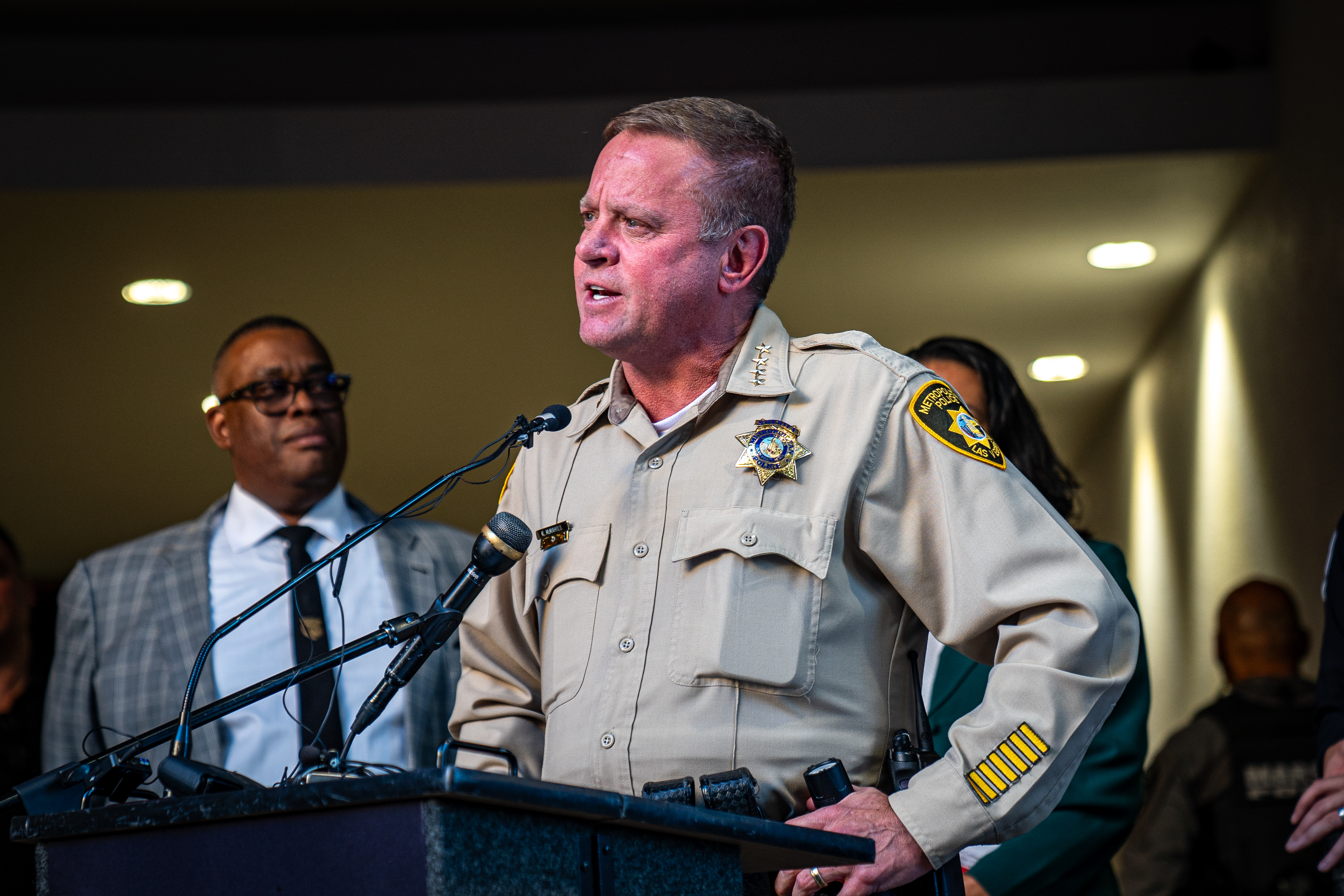 Sitting down for an in-depth interview with Vegas Legal Magazine, McMahill talks about the very busy end to his first year on the job. It’s a high-pressure job under normal circumstances. But November through February had been incredibly intense.
Sitting down for an in-depth interview with Vegas Legal Magazine, McMahill talks about the very busy end to his first year on the job. It’s a high-pressure job under normal circumstances. But November through February had been incredibly intense.
Normally, the period of November through February in the Las Vegas Valley is marked by the major events of New Years’ Eve celebrations on the Las Vegas Strip and the Consumer Electronics Show. The latter of which begins the first week of January.
But, this past November also saw FORMULA 1 racing’s return to Las Vegas, the week before Thanksgiving. Two months later, Las Vegas then hosted its first-ever Super Bowl on February 11th, at Allegiant Stadium.
The extra tourist attractions could be planned for, albeit still requiring a lot of police manpower to protect the public and participants. But in the midst of planning – and protecting – all these big events in Las Vegas, a tragedy happened: A mass shooting on Dec. 6th at UNLV. A disgruntled professor shot and killed three professors at UNLV, while wounding a fourth. University police shot and killed the alleged shooter, Tony Polito, who had been denied multiple job interviews for UNLV positions.
While it is somewhat easier to safeguard a contained event, such as the Super Bowl, large open-air sites — such as college campuses — are much more difficult to guard.
“I think UNLV is an open-air campus, and I think unless you literally built a 30-foot wall around it, you’re not keeping people out of there” the sheriff says. “It’s sort of what we talk about for the hospitality industry as well. Hospitality and security sometimes don’t necessarily go so well together. So, you have to find ways to work together, to keep the place safe. And, you know, that’s where that relationship comes in.”
Teamwork also comes into play when working with the UNLV, and Nevada System of Higher Education and the Clark County School District.
“I got to be clear, I don’t run policing services for UNLV,” he states. “A lot of people like to think that we do that for UNLV and the (Clark County) School District, but we don’t. What we do is we partner with them.”
McMahill does credit UNLV students with taking calls to “run, hide, fight” to heart.
“Those students performed very well” he praises. “They went and hunkered down (behind) those doors, and it required us to break most of them down to get the students out. Because they were not opening the door. They didn’t know what was on the other side.”
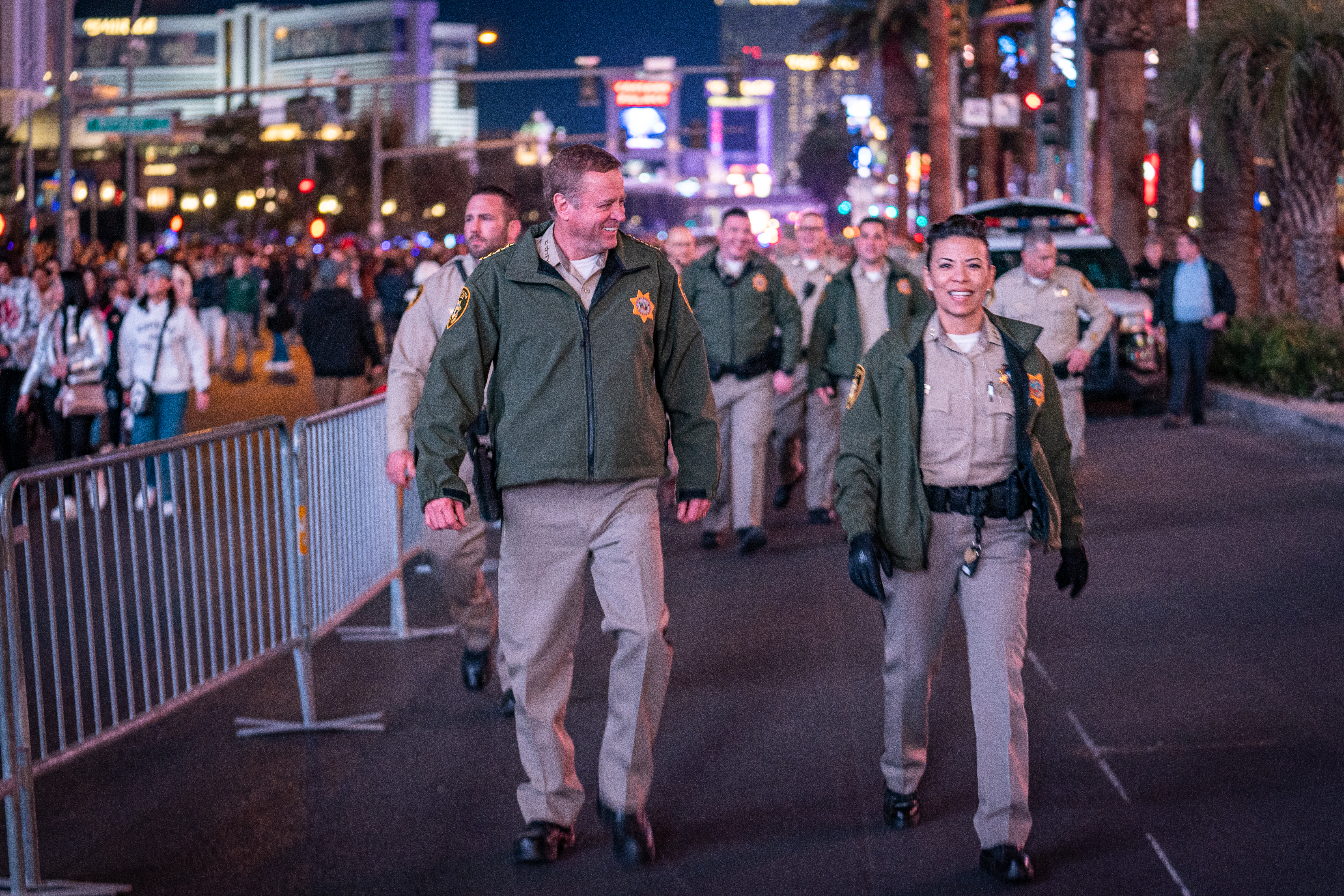 McMahill’s Whole Life Prepared Him to be Sheriff
McMahill’s Whole Life Prepared Him to be Sheriff
Kevin McMahill has been in public service, in some form, for most of his life. Starting at age 15 in his hometown of Denver, he was in the Police Explorers’ program. He was a Police Explorer until high school graduation.
“I had joined the military, in the delayed entry program at 17. And so, two days after I graduated high school, my parents dropped me off at the bus station and shipped me off to the Army,” McMahill recalls.
“So, I spent three years in the Army as a military police officer, and then came back down through (Las Vegas) and tested for both here and in Denver, and got hired at both. And, ultimately ended up here.”
In 2022, McMahill was elected sheriff, replacing then-Sheriff Joe Lombardo, who was elected governor of Nevada.
When McMahill arrived in Las Vegas in 1990, it was in the early boom-town era. The explosive growth has continued. The now-sheriff marvels at how the city has grown into a sports hub, with the Las Vegas Raiders, the Las Vegas Golden Knights, the Las Vegas Aces and soon, baseball’s Oakland A’s.
“I think probably the biggest thing that sticks out to a lot of people is we’re really on the verge of becoming a major American city, right? I mean, population-wise, we’re still far below places like New York, Chicago (and) Houston,” McMahill assesses. “But we now have professional hockey, professional soccer, women’s professional basketball, football (and) baseball’s on the way. And, obviously, we pulled all of those things off both with F1, New Year’s Eve and the Super Bowl. And I think Vegas shined really, really well in all of those.”
Taking a Bite Out of Crime
The new sheriff is pleased with a drop in major violent crimes over the last year.
“So last year, we went down basically 20 percent in robbery calls. We went down 13 percent in homicide calls and about 20 percent in sexual assault (calls),” McMahill reports. “Those are statistics I’m very, very proud of (and) that has a lot to do with a variety of different things.”
McMahill is also proud of Metro’s more-than 90 percent solve rate for homicides. He contrasts that to the city of Chicago’s much-lower rate of cracking murder cases.
“Last year, we were very close to a 100 percent solve rate. And that’s amazing. If you commit a homicide in Las Vegas, you are going to get caught,” the sheriff notes. “Contrast it to what you’re talking about with Chicago. Chicago hovers around a 30 percent solve rate. So, seven out of 10 people are getting away with homicide in the city of Chicago. So, (Chicago residents) don’t have faith, oftentimes, in their police to do the very basic things that people expect of their law enforcement. (That) is to solve crime and to arrest criminals.”
When police fail to do the basic things that are expected of them, such as putting murderers behind bars, it breeds distrust between law enforcement and residents. Chicago is an example of that type of dynamic, McMahill explains.
“But the one area that we were not successful (in) last year was in the auto theft area,” the sheriff admits. In particular, Metro has had to deal with a TikTok challenge of kids stealing Hyundais and Kias. To help combat that crime, Metro handed out auto-theft safety devices known as the Club. The department has since run out of Clubs, which were supplied by the manufacturers.
“Auto theft was up about 37 percent by the end of the year. And most of that is attributed to the Hyundai Kia TikTok challenge, where they’re teaching kids on the internet how to go and steal Hyundais and Kias by simply popping the button and putting the USB cord in, and taking (the vehicle),” the sheriff says.
McMahill does have some advice, which he offered to Vegas Legal Magazine. “So, for your readers, if they own a Hyundai: Number one, get the update from the company. That will help. Supposedly, that works for (preventing) these cars (from) being stolen.”
The sheriff also suggests Kia and Hyundai owners buy the Club, which locks the steering wheel in place.
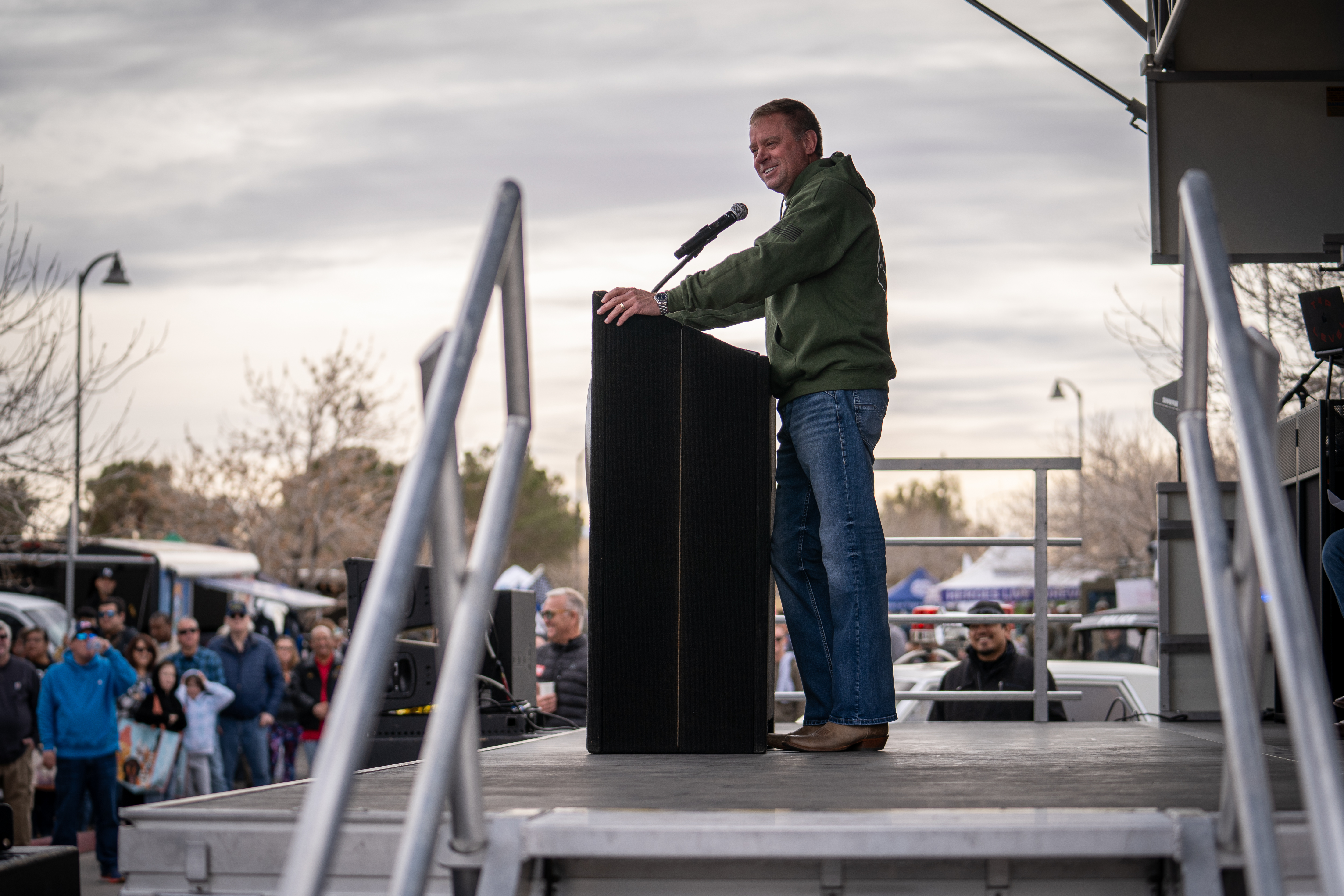 Retail Theft is a Crime on the Rise
Retail Theft is a Crime on the Rise
One crime that Nevadans can now see almost anywhere is retail theft. Specifically, today, organized retail theft is increasingly taking the place of run-of-the-mill shoplifters. McMahill laments the law passed by the Nevada Legislature, which raised the amount a person could steal, as a misdemeanor, to $1,250. That means thieves can potentially grab a huge amount of merchandise and walk away with only a misdemeanor citation.
“The best my cops can do is go in there and issue a citation, and that’s it. And that’s just not acceptable. And so, I think we have to have a real conversation about what are the consequences of some of the decisions,” McMahill explains. “I’m the first one that says all the time that incarceration doesn’t fix any of the illness that we have. It doesn’t fix mental health, addiction or homelessness. It just doesn’t. But you can’t just go into stores and wantonly steal up to $1,250 and get away with it over and over and over again.”
Metro works with the Nevada Retail Association and its retail crime task force, The Southern Nevada Organized Retail Crime Association, or SNORCA, to combat the growing theft. In the process, McMahill has learned some very worrisome details about the growing problem in Nevada.
“The heads of many of these companies — like Walmart, CVS, Walgreens, Lowe’s and Target — tell me that the retail theft that we have here in Southern Nevada is worse than it was in California when they closed many of their stores in San Francisco,” the sheriff cautions.
Metro Reduces Officer-Involved Shootings
Officer-involved shootings have been the match that has lit the fuse for social unrest over the last decade in America. From the police’s use of deadly force in Ferguson, Missouri in 2014 to the George Floyd riots of 2020 — the consequences of police using deadly force can devastate a whole community. Sometimes, deadly force is unavoidable. But other times, there may have been a better way to de-escalate in crisis situations.
In Las Vegas, Metro has been credited with successfully reducing officer-involved shootings over the last decade. McMahill is proud of the strides his department has made. And, it’s an ongoing effort.
“We were far ahead of the change curve when it came to use of deadly force. Obviously that was under Sheriff Doug Gillespie when we underwent the (Department of Justice) comprehensive use of force reform process, (after Metro officers) shot 25 people in 2010. We’ve significantly reduced those numbers,” he recalls. “And, that’s really the biggest flashpoint between police and the community, when we unnecessarily use force — particularly deadly force.”
As part of Metro’s process now, deadly-force incidents are reviewed and re-enacted, to examine what could have possibly been done differently.
“We built this beautiful reality-based training center … and the purpose of that was so we can go back out and recreate a scenario that ultimately ended in deadly force,” McMahill explains. “But in this scenario, now all of a sudden, you can find an alternative to deadly force.”
Foremost in dealing with the public is one very important thing, the sheriff says. “Inject humanity … Treat people with dignity and respect. Treat (people) like they are human, you know?”
Vegas Legal Magazine Questions for Sheriff Kevin McMahill
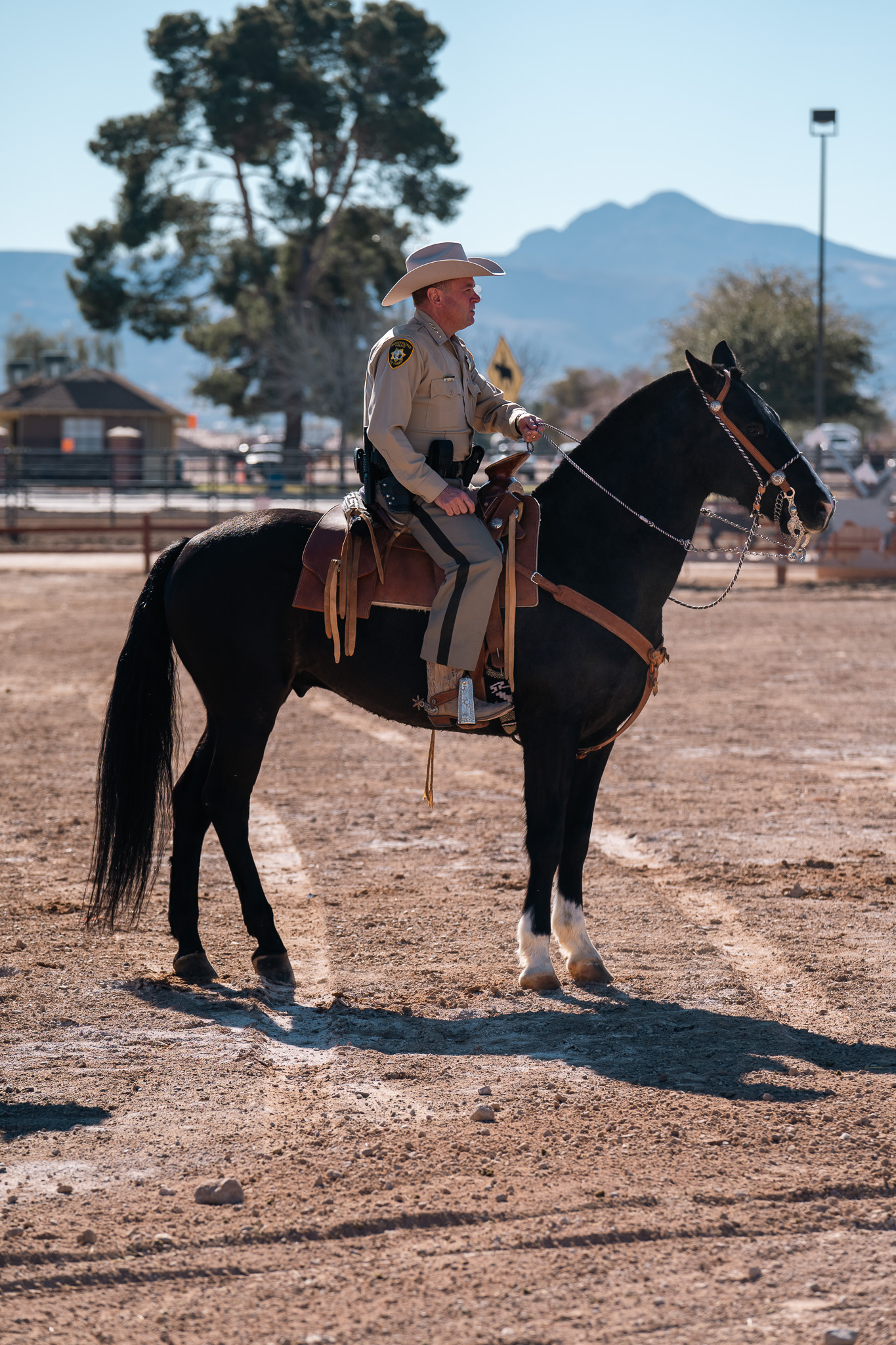
Vegas Legal Magazine: What policing challenges do you face as sheriff that your predecessors may not have faced?
Kevin McMahill: (One of the) challenges is I think today’s environment, right? We’re also politically divided, number one. The police are often caught up in how one group or the other feels about them. And so, it’s a real challenge to continue to have your men and women focused on keeping the community safe when there’s so much public vitriol out there about law enforcement, and the role that we play. And so, helping redefine that, as we move forward, is something that’s been very important.
VLM: You were at Metro during the 1 October mass shooting. How did that tragic event change the way the department handles potential mass-casualty events?
KM: There are two buildings that cost $28 million to build, all obtained through private donations. And it’s called the JETI, the Joint Emergency Training Institute. And it’s basically one of the two buildings. And it’s pretty much brand new to Metro. The beauty of that though, and this is something that we learned from 1 October, see, this gives us the opportunity to train with police, fire, EMS private security in one space, in one location. So, that when it really does happen again — which (the mass shooting at) UNLV proved — we have seamless effort between all of the Southern Nevada first responders community.
And, the 1 October report had a significant number of recommendations for us to change the way that we operated. Things like making sure the command post is not located inside of the event when it happens. Because, when the bullets came raining down on Route 91, our command post was located inside, and they were being fired upon.
And, having paramedics respond (to the scene, while) off-duty paramedics respond to the hospital. […] a paramedic can start a main line and a chest tube, but a regular EMT cannot, or a nurse oftentimes cannot. So, doctors were coming out having to do the nurse’s job, and nurses were doing the paramedic’s job. So now we’ve developed a joint response with the fire department, that on-duty resources will go to the event. And, so now we’ve developed a joint response with the fire department, that on-duty resources will go to the event.
And when those off-duty resources hear about the event and they’re coming in, they’ll be redirected straight directly to the hospitals. So, that we have the ability of paramedics to be there for triage and mainlines and those kind of things. Nurses can do their jobs in prepping for surgery and doctors can actually do the surgery. And it’s something that we teach all across the country. That unified command piece where police, fire, and EMS are all in the same location. That has proven just to be magical for us, moving forward from 1 October. We work very, very well with our fire departments and our EMS.
VLM: One of the highest-profile arrests ever made by Metro was made last fall. Duane “Keffe D” Davis was arrested and charged with the 1996 Las Vegas murder of rapper Tupac Shakur. Why was it important to solve that case after nearly 30 years?
KM: Well, there was a lot going on when this first happened. There was a variety of different people involved in it. And … that was the sort of beginning of the gang culture and not talking to the police, and all of those kinds of things. And so, we were up against a number of those challenges. But a lot of these suspects lived in Los Angeles and they were involved with the Los Angeles Police (Department). And some of that stuff, as it continues to come out through this trial, will be interesting adding to the narrative about what happened.
VLM: Is there any expectation that there might be other arrests or any high-profile arrests (in the Tupac murder), or do you think this will be the one arrest of the surviving people involved? Is he the last one?
KM: The last one? Yeah. So, there’s a number of pieces of the investigation that obviously (we) can’t reveal before we get to the trial piece. But I don’t anticipate any large or — any high-profile arrests coming out of this, any further.
VLM: You have said that the Clark County Detention Center is “the largest homeless shelter (and) the largest addiction-treatment center” in Southern Nevada. People had also long called the Clark County Detention Center the “largest mental-health facility” in the valley. How would you propose handling the homeless problem in the Las Vegas Valley?
KM: Incarceration’s not going to fix any one of those three things — Addiction, homelessness, or mental health. So, I’ve been working with a number of other city and county elected officials, as well as the state, the governor’s office, as a coalition of all the Strip properties. We’ve traveled to San Antonio to look at Corridor of Hope, which is their homeless shelter.
And we are looking at duplicating the same type of effort that San Antonio has had. We’ve also traveled to Tucson and Miami looking at what they’ve done. We’re looking at these community crisis centers here. There’s $100 million being put up by the Strip properties, as well as some matching funds coming from the state government. So, that we can truly actually have beds and wraparound treatment services for these individuals.
Because the reality of it is, people aren’t choosing to be addicted. They’re not choosing to be mentally ill. They’re not choosing to be homeless. And they all almost always go with one or the other. It’s very rare that you find somebody who’s mentally ill who has not dabbled in the narcotics or vice versa, which oftentimes leads to being homeless. And so, if you don’t treat all of them at the same time, to actually get some meaningful treatment to them … including jobs … we’re going be sitting here looking like one of these other cities that we don’t want to mention, very, very soon.
The other argument that I would tell you is, it’s also not okay to just completely decriminalize all the behavior of a homeless individual. In other words, they shouldn’t be allowed to park their cars on every street. They shouldn’t be allowed to sleep in front of the doorways of businesses. They shouldn’t be allowed to do all of those things. But I believe we, as a community can do a lot better. And I don’t believe that we should let them sleep in the tunnels.
Valerie Miller is a Las Vegas Valley-based award-winning journalist. She can be reached at (702) 683-3986 or valeriemusicmagic@yahoo.com.

Leave a Comment